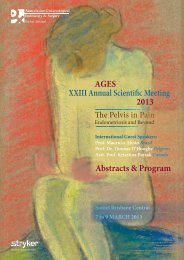to Obstetric Trauma Pelvic Floor Repair Surgical Essentials - AGES
to Obstetric Trauma Pelvic Floor Repair Surgical Essentials - AGES
to Obstetric Trauma Pelvic Floor Repair Surgical Essentials - AGES
Create successful ePaper yourself
Turn your PDF publications into a flip-book with our unique Google optimized e-Paper software.
<strong>AGES</strong><br />
<strong>Pelvic</strong> <strong>Floor</strong><br />
Symposium &<br />
Workshop XII<br />
2011<br />
<strong>to</strong><br />
<strong>Obstetric</strong> <strong>Trauma</strong><br />
<strong>Pelvic</strong> <strong>Floor</strong> <strong>Repair</strong><br />
<strong>Surgical</strong> <strong>Essentials</strong><br />
12<br />
There are concerted efforts <strong>to</strong> confront the problem posed through<br />
leva<strong>to</strong>r trauma. Investiga<strong>to</strong>rs have already started <strong>to</strong> develop potential<br />
methods <strong>to</strong> prevent leva<strong>to</strong>r trauma in labour ward. There have also<br />
been reports of attempts <strong>to</strong> repair such trauma. Effects of vaginal mesh<br />
kits on leva<strong>to</strong>r biomechanics are emerging. Research efforts have now<br />
been urgently directed <strong>to</strong> ways <strong>to</strong> correct or compensate for altered<br />
biomechanics due <strong>to</strong> either leva<strong>to</strong>r avulsion or leva<strong>to</strong>r ballooning.<br />
REFERENCES:<br />
1. Dietz HP, Gillespie A, Phadke P. Avulsion of the pubovisceral<br />
muscle associated with large vaginal tear after Normal Vaginal<br />
Delivery at term. A Case Report. ANZJOG 2007; 47: 341-44<br />
2. Adekanmi OA, Freeman RM, Jackson SA, Puckett M, Bombieri<br />
L, Waterfield MR. Do the ana<strong>to</strong>mical defects associated with<br />
cys<strong>to</strong>cele affect the outcome of the anterior repair A clinical and<br />
radiological study. Int Urogynecol J <strong>Pelvic</strong> <strong>Floor</strong> Dysfunct. 2009<br />
Nov;20(11):1369-77.<br />
3. Dietz HP . The Role of Two- and Three-Dimensional Dynamic<br />
Ultrasonography in <strong>Pelvic</strong> Organ Prolapse. J Min Inv Gynecol<br />
2010; 17:282-294<br />
4. San<strong>to</strong>ro GA, Wieczorek AP, Dietz HP, Mellgren A, Sultan AH,<br />
Shobeiri SA, Stankiewicz A, Bartram C. State of the art: an<br />
integrated approach <strong>to</strong> pelvic floor ultrasonography. Ultrasound<br />
Obstet Gynecol. 2011 Apr;37(4):381-96.<br />
ACKNOWLEDGEMENT: I am grateful for the opportunity <strong>to</strong> learn<br />
<strong>Pelvic</strong> <strong>Floor</strong> USS with Prof H.P.Dietz. References <strong>to</strong> the above texts<br />
can be found below.<br />
AUTHOR AFFILIATION: Joseph Lee, FRANZCOG Urogynaecology<br />
Fellow, Monash Medical Centre, Moorabbin; Mercy Hospital for<br />
Women Heidelberg, Vic<strong>to</strong>ria, Australia.<br />
Session 5 / 0910-0930<br />
Postnatal voiding dysfunction<br />
Lotze P<br />
The diagnosis of postnatal voiding dysfunction requires careful attention<br />
<strong>to</strong> the post-partum patient, maintaining clear records of spontaneous<br />
voids, and rapidly assessing those patients who are suspected <strong>to</strong> have<br />
retention. Bladder function is recognized <strong>to</strong> change during pregnancy<br />
and the immediate post-partum period. Those changes can include<br />
increased bladder capacity, altered bladder sensations, and an<br />
increased post-void residual. The route of delivery, anaesthesia applied,<br />
as well as the use of forceps are also among numerous risk fac<strong>to</strong>rs<br />
which can alter the patient’s ability <strong>to</strong> void following delivery.<br />
The mechanisms of moni<strong>to</strong>ring post-partum patients voiding varies<br />
from country <strong>to</strong> country. However, the guidelines developed by<br />
national governing bodies generally are very similar with respect <strong>to</strong><br />
managing the bladder during labor and expected time <strong>to</strong> first void<br />
following delivery. Despite the availability of these guidelines, few<br />
hospitals implement measures <strong>to</strong> moni<strong>to</strong>r patients and minimize this<br />
risk. Further, those systems that are in place often differ significantly<br />
from one another.<br />
When detected, postnatal voiding dysfunction generally warrants<br />
immediate catheterization of the bladder <strong>to</strong> avoid risks associated<br />
with overdistention. In most cases, the duration for catheterization<br />
is brief. Recommendations on patient management are available for<br />
patients requiring greater durations of catheterization. Alternatives<br />
<strong>to</strong> catheterization, such as medications, have a very limited role in<br />
voiding dysfunction.<br />
RECOMMENDED READING:<br />
1. Govt of South Australia, Dept of Health. Perinatal Practice<br />
Guidelines: Postpartum Bladder Dysfunction. Section 6; Chapter<br />
108. Developed 2005; Reviewed 2009. www.health.sa.gov.au/<br />
PPG/Default.aspxPageContentID=1379&tabid=185<br />
2. Lim J. Post-partum voiding dysfunction and urinary retention.<br />
Aust N Z J Obstet Gynecol (2010) 50: 502-505.<br />
AUTHOR AFFILIATION: Peter Lotze, MD, FACOG; Fellowship<br />
Direc<strong>to</strong>r, Urogynecology and <strong>Pelvic</strong> Reconstructive Surgery Women’s<br />
<strong>Pelvic</strong> Health & Continence Center Clinical Assistant Professor,<br />
Division of Urogynecology, Dept of OB/Gyn UTHSC-Hous<strong>to</strong>n; Baylor<br />
College of Medicine Hous<strong>to</strong>n, Texas, USA.<br />
Session 5 / 0930 - 0950<br />
<strong>Obstetric</strong> trauma: what<br />
physiotherapy can offer<br />
Neumann P, Sherburn M<br />
The management of severe perineal trauma from a physiotherapy<br />
perspective will be presented, including data about the role of<br />
physiotherapists in the care of the perineum after childbirth from<br />
a 2008-09 survey of member hospitals in the Women’s Hospitals<br />
Australasia network. In the absence of adequate guidelines on<br />
the post-surgical management of 30/40 lacerations, a framework<br />
for physiotherapy management will be presented, based on the<br />
principles of tissue healing, sports medicine and extrapolation from<br />
orthopaedic surgery.

















